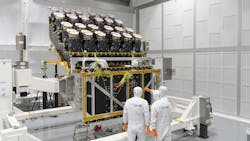ESA's PLATO space telescope features unique camera system
COLOGNE, Germany - Are there planets similar to Earth? Do they orbit stars like our Sun? How do planetary systems form and evolve? To answer these and other questions, the European Space Agency (ESA) will launch the PLATO (PLAnetary Transits and Oscillations of stars) mission at the end of 2026. From 2027, it will begin its search for planets beyond our Solar System – with a particular focus on Earth-sized planets orbiting Sun-like stars. A major mission milestone has now been reached – from 10 to 13 June 2025, the telescope's two main components were integrated at the site of the aerospace and technology company OHB in Oberpfaffenhofen, Germany.
Continue reading original article.
The Military & Aerospace Electronics take:
1 July 2025 - "Almost exactly eight years to the day since ESA gave the green light for the PLATO mission, both the satellite and its unique telescope with 26 'eyes' have been completed on schedule," explains Heike Rauer, scientific lead of the mission from DLR and Freie Universität Berlin. "This is an outstanding achievement. Unlike many other space telescopes, PLATO doesn't rely on just one complex telescope camera – it uses 26 cameras in total. They will enable PLATO to observe approximately 250,000 stars for any orbiting planets. The 26 sensitive cameras were built and tested in the member states of the payload consortium. The international cooperation between consortium members and ESA has worked exceptionally well. All tests completed so far suggest that PLATO will deliver the planned and required measurement accuracy."
Unlike traditional space telescopes with a single large mirror, PLATO uses 26 individual cameras on a shared platform. From its future orbit at the L2 Lagrange point—1.5 million kilometers from Earth—PLATO will monitor roughly 250,000 stars in search of exoplanets. It will use the transit method, detecting tiny dips in starlight caused by orbiting planets, a technique also used by NASA’s Kepler and the CoRoT mission. Scientists anticipate the discovery of thousands of new rocky, icy, and gaseous worlds orbiting stars of various types.
Related: NASA seeks industry support for aerocapture demo mission in Earth orbit
Related: NASA, ANU team up for Artemis II lunar laser communications test
Jamie Whitney, Senior Editor
Military + Aerospace Electronics
